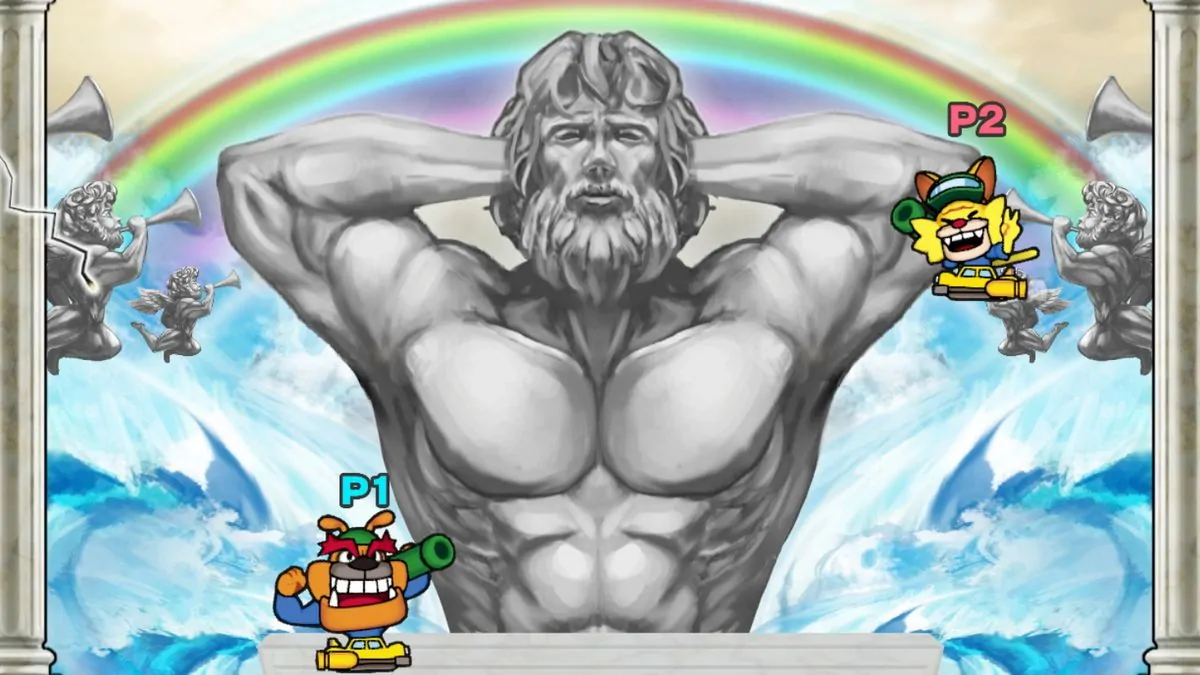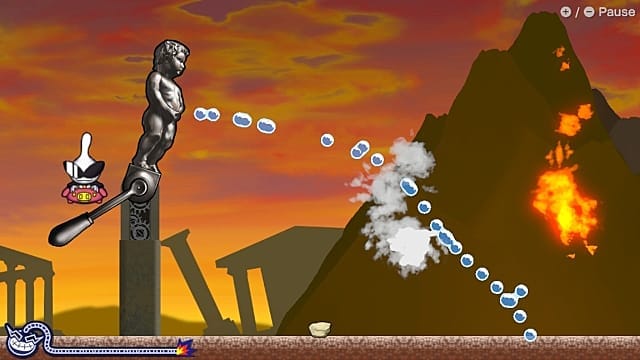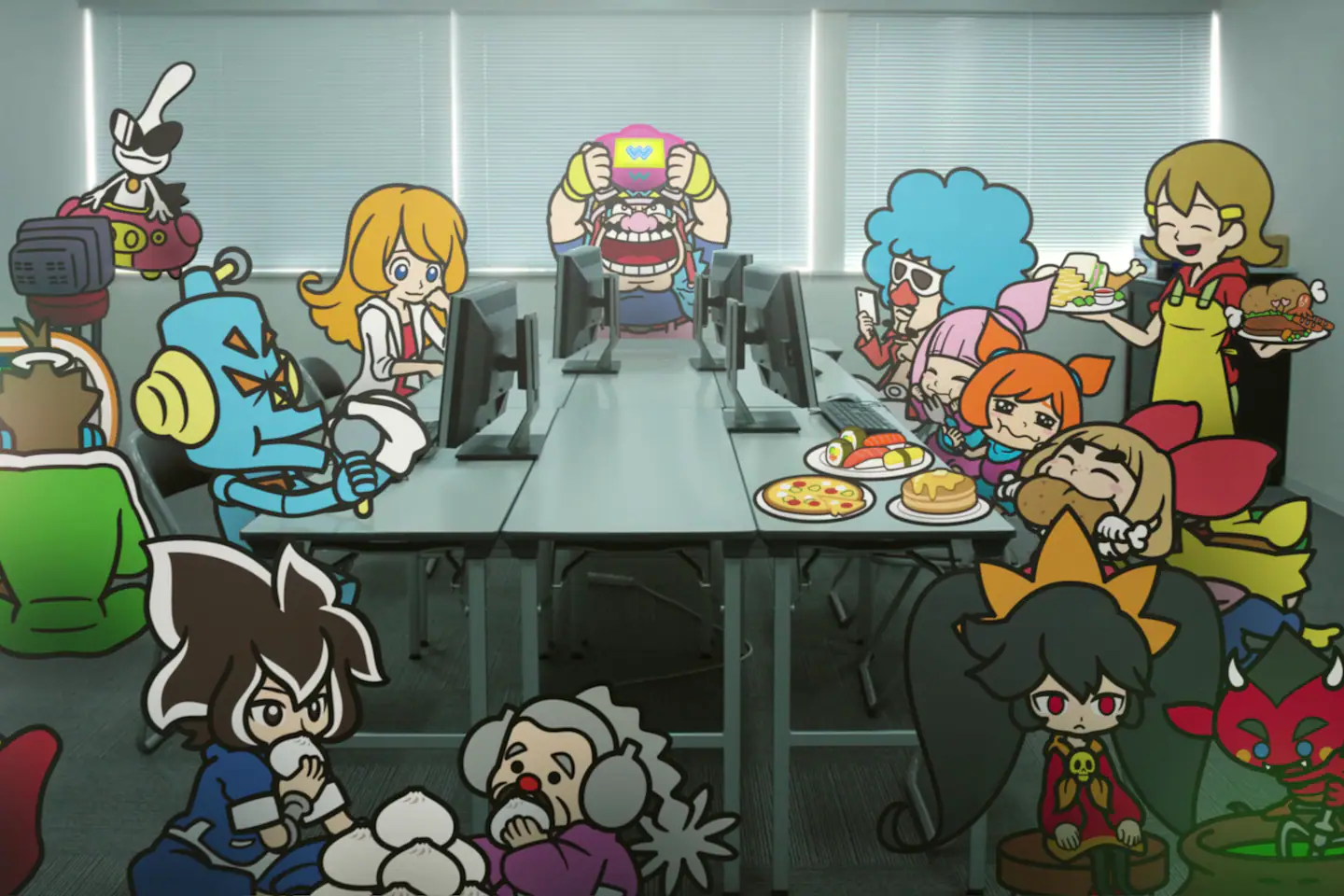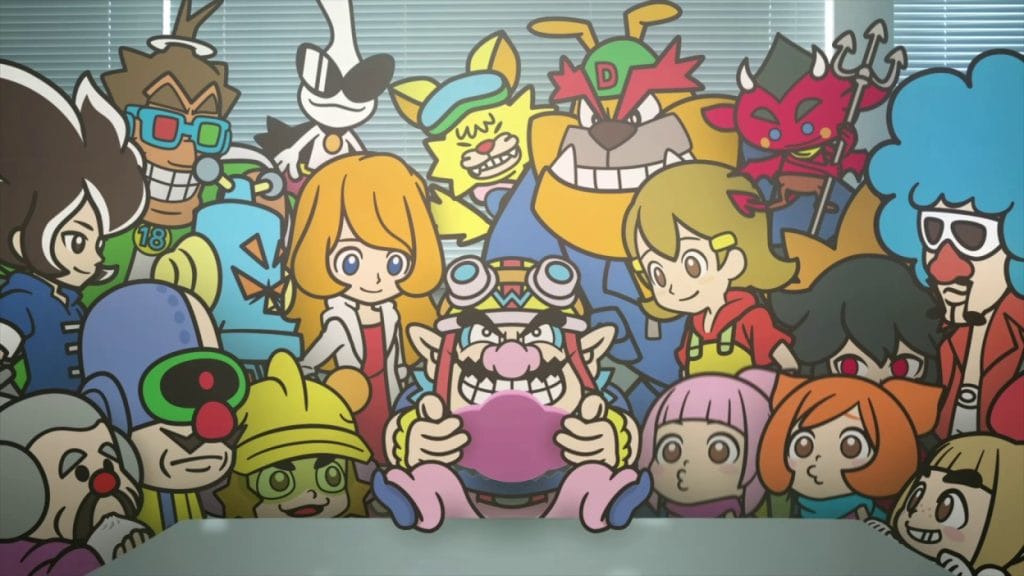A video game can be all kinds of things. It can be an epic journey through space, a challenge to ward off a zombie invasion, a high-stakes soccer match, a cyberpunk-inspired street race, or whatever else the human mind can imagine. Many years ago, however, a little Game Boy Advance title called WarioWare, Inc.: Mega Microgames! dared to ask the question, “What if a video game were just a series of random actions without any consistency or greater purpose?”
Nearly two decades later, Nintendo and developer Intelligent Systems are still operating under the thesis that a game (or collection of games) only needs to do one thing: Compel the player to perform a particular action in a particular context. Regardless of what that action is, it just needs to be done. Everything else, after you boil it down, amounts to added flavor.
While its zaniness and party-game nature separate it from the AAA darlings and so-called “bangers” that players typically want from big gaming companies, there’s a certain purity to WarioWare that I’ve always admired. Beyond just being a hilarious and all-around fun time, WarioWare explores the idea that video games themselves are basically a collection of arbitrary actions and commands that the player must abide by. In some cases, the player performs an action simply because they are told to do so. At the very least, WarioWare is honest and upfront about that.

The Skinny on WarioWare
For those unfamiliar with the chaotic genius of the WarioWare franchise, here’s the skinny: WarioWare, Inc. is a gaming company owned by the mischievous and greedy Wario himself, whose games are bizarre and extremely short. The player must make their way through a collection of these tiny experiences either to achieve a certain milestone (e.g., 15 games completed) or just to see how long they can survive. Each WarioWare title has some kind of story mode that involves different collections of so-called “microgames.” (Think mini-games, except even smaller.) These microgames are typically organized by theme (e.g., animals, food, sports, or even other classic Nintendo games).
Each microgame is only a matter of seconds long and commands the player to complete a task correctly and swiftly. There are only two outcomes to each microgame: You do it right, or you don’t. There is no in-between. What makes WarioWare special, however, is that these tiny games can be literally anything, including picking someone’s nose, drinking a glass of water without spilling it, rolling all the toilet paper off of the roll, or ripping out a statue’s armpit hair. There is no consistent art style or genre theme at play, and while there is a story, completing that story is not the main purpose of this franchise’s existence. The real crux of the experience is going for high scores, seeing how long you can survive an onslaught of increasingly difficult and ridiculous challenges that may involve covering a cat turd in a panic. In WarioWare, chaos is the point.

The latest edition in the franchise, WarioWare: Get It Together!, ups the ante with a wide collection of playable avatars. In this version, players control various characters from the WarioWare canon, including Wario himself, to complete each microgame, and each character has a different control scheme that will provide advantages in certain games and disadvantages in others. For example, Wario can move freely across the screen, and pressing the A button makes him do a lateral charge. Meanwhile, 18-Volt can’t move at all, but can throw discs in any direction he wants to. Mike can move freely and shoot projectiles upward, Mona floats around on an aerial moped and throws a boomerang, and Jimmy T can only move by charging in the direction in which he is pointing.
The mechanically diverse cast potentially doubles the challenge of each microgame, as the player has to both navigate the game itself while also utilizing a different character’s unique abilities. For most challenges, the player must either select a certain number of characters to rotate through each game, or opt to rotate through ALL of them, which is the toughest and most chaotic way to play.

What’s It Really About?
So what exactly is the point of a WarioWare game? Is it to challenge a player’s immediate reflexes? Is it to create the perfect party experience? Is it to showcase the broad range of actions the player can perform in a video game? Is it just to present a wacky, fun jaunt? The answer to all of these questions is a resounding “Yes,” but the core of what makes WarioWare tick is so much more intriguing.
At the crux of WarioWare is a metacommentary on gaming itself, with each entry in the franchise arguing that the relationship between the game and the player is that of a leader and follower. Sure, the player opts in at first, but from there the player typically does what is asked of them, as long as they are still interested and having fun. You shoot at Covenant forces in Halo because Bungie said it’s the only way to proceed with the story. You reach for the floating star in Super Mario 64 because that’s the only way to finish the level. You search for the Big Key in a Legend of Zelda game because you need it to fight the final boss, and you have to beat the final boss because Nintendo said you have to. Even the most open-ended of games follow this line of thinking to a certain extent, as the player is still given a task, even if the “how” has yet to be discovered (think of how Dishonored tells you to locate certain people and places, but doesn’t command you to take a certain route there).

To be clear: I am not personally saying that EVERY game is like this, or even that the leader/follower relationship is inherently bad. When I turn on my Xbox or Switch, I like to have a sense of what I’m supposed to do or what goals I’m looking to accomplish. While I can create my own goals (and tend to do so in games like WarioWare), I still must do so on the terms set out for me. For example, I can challenge myself to get -10 on a certain course in Mario Golf: Super Rush, but to do so, I must play golf the way the game taught me to.

So What’s New?
I’ve really enjoyed my time with WarioWare: Get It Together!, and not merely because I enjoy the general conceit of WarioWare games and will always welcome more. Overall, I appreciate how the wide variety of character choices makes every revisit to a microgame feel brand new, making the collection of 200 games actually feel closer to 1,000. There might not be that many different game modes, but most of that stuff in party games is filler anyway. The level of variety in the core experience of Get It Together provides hours and hours of worthwhile gameplay on its own, and I can see myself trying to best my highest scores for the foreseeable future.
Moreover, the metacommentary is more front-and-center in Get It Together than ever before. In the title’s main story, Wario and his friends are sucked into the video games they have created, meaning instead of the player being commanded to act by Wario and company, they are controlling such characters being commanded by the very interactive experiences they built. The relationship between the game and the player expands in Get It Together in such a way that the lines are blurred; the game itself is a collection of players, and the players themselves made the game. But even where that connection becomes murkier than usual, Get It Together never wavers on that fundamental premise: At the end of the day, the game tells you to do something, and then you just do it. Wario made these microgames, and even he is at their beck and call.
Much like previous entries in the series, the latest WarioWare claims that there’s fundamentally little difference between “Leave the candy!” and Ghost of Tsushima when it comes to that game/player relationship. Get It Together even takes it a step further, contending that by offering a wide array of control setups with different characters (as well as cooperative multiplayer), each action can be taken in any number of ways, even if the result ultimately feels the same. Giving each microgame a variety of ways to play makes everything feel different each time, but ultimately you’re still doing the same thing. It’s like how Dark Souls has you stabbing demons while Doom has you shooting them: Each game offers different ways to eliminate a similar group of targets they have carefully and thoughtfully set out for you, the player.

If everything I’m saying sounds like nonsense, that’s probably because it is. As far as galaxy-brain takes on fairly straightforward art goes, “Video games are basically just a list of random tasks and commands for people who are into that” is perhaps a bridge too far. But it’s hard for me not to think about my relationship to gaming as a concept every time I boot up a console and react to what’s on screen.
With just about every game I play, I ask myself, “Why am I doing this? What do I like or dislike this? What do I actually want from this endeavor?” With WarioWare: Get It Together!, these questions were answered within minutes of playing. I found the simplicity and directness of the experience calming, since I never had the time to ponder the purpose of any of it. I was told to avoid giant boxer fists or make a gymnast shimmy, and I did so immediately. Maybe that’s why this medium resonates with me so much; sometimes, I just like being told to do something and gain immediate satisfaction from doing it. More so than any of its peers, WarioWare is honest about how it fulfills that desire.
Sam has been playing video games since his earliest years and has been writing about them since 2016. He’s a big fan of Nintendo games and complaining about The Last of Us Part II. You either agree wholeheartedly with his opinions or despise them. There is no in between.
A lifelong New Yorker, Sam views gaming as far more than a silly little pastime, and hopes though critical analysis and in-depth reviews to better understand the medium's artistic merit.
Twitter: @sam_martinelli.










